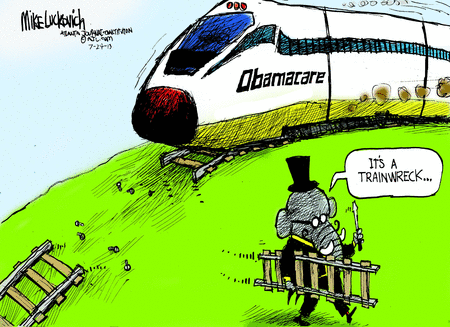House Throws Down the Gauntlet, Challenging Obama
The extreme right of the House could not be contained despite warnings of blow back by Speaker John Boehner. A week before the government runs out of money for its operations and three or so weeks before the nation bumps against the debt ceiling, a party line vote of 230 to 189 expands the nation’s borrowing authority to pay its bills only if all funding of Obamacare is eliminated. There is no chance that the Senate will agree, nor will President Obama negotiate this time, so a government shutdown and the nation’s first ever default on its debts are so far the only foreseeable outcome. “It’s going to be fight every hedgerow, fight every ditch. It’s just like trench warfare in World War I”, was the prediction in Bloomberg/Business Week of Tim Jost, a health law professor at Washington and Lee School of Law. Conservatives and Libertarians despise the healthcare law as government overreach for forcing people to buy what they might prefer not to, and for helping them buy it with a massive program of subsidies that the Wall Street Journal estimated will run to $1.762 trillion over 10 years. The Journal editorial page said, “This is Mr. Obama’s dream of expanding government to create a permanent entitlement state”. Republicans in and out of the government are deploying every weapon in their arsenal to defeat the Affordable Care Act (ACA), with tactics that go well beyond their symbolic but futile 42 attempts to repeal the Act in the House. Key to Obamacare’s success is bringing everyone into the insurance pool, with premiums paid by the young and healthier counterbalancing the costs of the older with medical problems. But a weakness in the law sets the penalty for the uncooperative well below the cost of insurance, and nothing in the rules prevents them from waiting to opt in only when and if they become ill at some future date. The Tea Party group FreedomWorks is encouraging Millennials to do just that — don’t buy in until they acquire that pre-existing condition that insurers cannot turn away. Failure is assured for a law that “depends on people acting against their self-interest” is Ramesh Ponnuru’s view at Bloomberg.com. “Why is free-loading now a conservative value”, asks Andrew Sullivan at The Dish. quid pro quo
In Obama’s granting of a reprieve to businesses, postponing for a year the requirement that those with over 50 employees pay for their insurance, Republicans in the House saw an opening to crush the economics of Obamacare. They passed a parallel measure that said that if businesses need not comply, neither should the public have to in that first year. It even attracted 22 Democrats. If those with pre-existing conditions cannot be turned away, postponement of the mandate that everyone must join the pool means that insurance costs would zoom, which Obamacare opponents assume would cause a public outcry for repeal that even Democrats in Congress could not deny to their constituents. Neglecting other business just before taking a five-week vacation, the House then voted to prohibit the Internal Revenue Service from involvement in the law. Its role is crucial. Subsidies take the form of tax credits, which the IRS would administer. And it is to act as the enforcer, imposing penalties on individuals and companies who fail to meet the law’s requirements. House Majority Leader Eric Cantor (R-Va) says “The IRS” — in his view all of it, apparently, not just the Cincinnati unit discovered using keyword searches to find political non-profits applying for tax-free status — “has been abusing its power” and “the last thing we should do is to allow the IRS to play such a central role in our health care”. The IRS “will have access to the American people’s protected health care information”, said Cantor. That happens to be an absolute falsehood. These efforts at sabotage, like the 40 bills for repeal, cannot hope to survive the President’s veto, of course, but such negativism serves to set the public against the law. A majority would like to see it repealed. But probed a little further one finds that majority is filled with those whose companies pay for their health insurance; they are covered and don’t want anything to change. Not until after repeal and an eventuality that some lose their jobs, say, and discover what an individual’s insurance policy costs absent the new exchanges or that even a minor pre-existing condition gives insurers an excuse to deny them insurance altogether, would they realize that their former negative opinion was ill-considered. Beyond the Beltway
The group co-founded by Karl Rove, Crossroads GPS, is running an over the top video clumsily called ObamaCareNado that has a tornado causing “a rising tide [sic] of health care costs” with “nobody safe from its wrath”. Dick Armey’s creation, FreedomWorks, advises everyone to burn their Obamacare cards as an act of protest. But there are no Obamacare cards. FreedomWorks intends to design one that you can print from the Internet, and then burn. (We’re not kidding). More serious are the scores of law suits around the country that take aim at Obamacare’s particulars. Catholic run organizations want the requirement that insurers must pay for contraceptives struck down. The Goldwater Institute has sued to eliminate the Independent Payment Advisory Board — the “death Panel” that would “ration” care if costs exceed targets. One case even wants to invalidate the law altogether because spending bills should originate in the House, says the Constitution, but the ACA was first passed by the Senate. Another suit says that there is no provision for subsidies to be issued by federally conducted exchanges — the insurance marketplaces that the government must set up when states fail to do so — a calamitous defect thanks to faulty wording in the law. “Almost no law as sprawling and consequential as the Affordable Care Act has passed without changes … known as ‘technical corrections’ …in subsequent months and years”, The New York Times and others have pointed out, listing a number of examples. But there’s the rub. It is Congress’ job to make such repairs, but Republicans intend to block any fixes whatsoever as their way to bring Obamacare crashing down. the nuclear option
With no budget passed or even considered for the federal fiscal year that begins October 1, the government needs legislators to pass a spending resolution if there is to be money to pay its bills — bills that include such items as Social Security payments and military paychecks. So as a last desperate act to cripple Obamacare, a group of Republican senators teamed with representatives in the House to pursue a defunding option. In a July speech on the Senate floor, Mike Lee (R-Ut) said, “As long as President Obama selectively enforces Obamacare, no annual appropriations bill or continuing resolution should further fund implementation of the law…If the president won’t follow it, the American people shouldn’t fund it”. Co-sponsor Texas’ rookie senator Ted Cruz says that “Under no circumstances will we support a continuing resolution that funds a penny of Obamacare”. If Republicans go through with their threat, avoiding a shutdown of the government calls for President Obama to agree to the effective repeal of his most significant achievement. The likelihood of his doing that is rated at near 0%. Republicans do not see a repeat of 1995 when they were blamed for 28 days of shutdown using the same tactic against President Clinton. This time it’s different, they say, because Obamacare is so unpopular with the public. With Congress back in the home districts during August, Republican groups are fomenting angry town hall sessions to badger their representatives to vote for defunding or else shutdown. Charles Krauthammer, the conservative columnist at The Washington Post, says about shutdown and Republican prospects, “If I thought it would work, I would support it. But I don’t fancy suicide. It has a tendency to be fatal”. are we still a democracy?
It bespeaks an ugly turn of democratic government when lawmakers deploy every tactic to defeat and defund a law that was passed by their own legislative body, signed by the President and validated by the Supreme Court because it is not to their liking. Obama looks at another way: “I think a really interesting question is why it is that my friends in the other party have made the idea of preventing these people from getting health care their holy grail, their #1 priority. The one unifying principle in the Republican Party at the moment is making sure that 30 million people don’t have health care”, he said in his early-August press conference. “At least they used to say, well, we’re going to replace it with something better. There’s not even a pretense now that they’re going to replace it with something better. It’s become an ideological fixation”.


